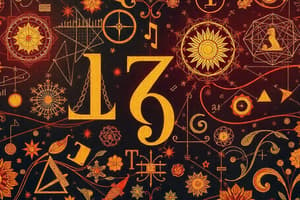Podcast
Questions and Answers
What is the negation of the statement 'Karel is beautiful'?
What is the negation of the statement 'Karel is beautiful'?
- Karel is attractive
- Karel is not beautiful (correct)
- Karel is ugly
- Karel is handsome
What is the purpose of using lowercase letters (p, q, r, s) in logic statements?
What is the purpose of using lowercase letters (p, q, r, s) in logic statements?
- To label statements (correct)
- To label questions
- To label instructions
- To label opinions
What is the logical connective typically notated as 'V' and read aloud as 'or'?
What is the logical connective typically notated as 'V' and read aloud as 'or'?
- If-then
- Negation
- Conjunction
- Disjunction (correct)
What is an example of a compound statement?
What is an example of a compound statement?
What is the purpose of using 'T' and 'F' in logic statements?
What is the purpose of using 'T' and 'F' in logic statements?
What is the conjunction of two simple statements?
What is the conjunction of two simple statements?
What is the purpose of using connectives in logic statements?
What is the purpose of using connectives in logic statements?
What is a declarative sentence that can be classified as either true or false?
What is a declarative sentence that can be classified as either true or false?
What is a truth table?
What is a truth table?
What is the principle of double negation?
What is the principle of double negation?
What is the conjunction of two statements P and Q?
What is the conjunction of two statements P and Q?
What is the disjunction of two statements P and Q?
What is the disjunction of two statements P and Q?
What is an equivalent statement?
What is an equivalent statement?
What is a tautology?
What is a tautology?
What is the negation of a statement P?
What is the negation of a statement P?
What is the conditional statement 'if p, then q'?
What is the conditional statement 'if p, then q'?
Flashcards are hidden until you start studying
Study Notes
Pioneers of Logic
- Augustus De Morgan and George Boole contributed to the advancement of symbolic logic as a mathematical discipline.
Logic Statements
- A declarative sentence that can be classified as either true or false.
- A statement cannot be a question, an instruction, or an opinion.
- Examples: "Every triangle has three sides", "The price of a Samsung Galaxy tablet was Php 11, 000 on December 24, 2014".
- Statements are usually labeled with lowercase letters (p, q, r, s, etc.).
- True statements are denoted by T, and false statements are denoted by F.
Compound Statements
- Formed by connecting two or more statements or by negating a single statement.
- Connectives used to form compound statements: Not, And, Or, If-then.
Negation
- The negation of a simple statement is the opposite of the original statement.
- Usually done by putting "not" into the statement.
Conjunction
- Two simple statements are combined with the word "and".
Disjunction
- A logical connective typically notated as "V" and read aloud as "or".
- Examples: "Today is Friday and it is raining", "It is not raining and I am going to a movie".
Truth Tables
- A breakdown of a logic function by listing all possible values the function can attain.
- A table typically contains several rows and columns, with the top row representing the logical variables and combinations.
Negation, Double Negation, Conjunction, and Disjunction Truth Tables
- Each table lists all possible values for the respective logical operation.
Equivalent Statements
- Theorem that states "If a statement is true, then it is not the case that the statement is not true".
Tautologies
- A statement represented by an entire column of T values in a truth table.
- Such a proposition is always true, no matter what.
Conditional and Biconditional Statements
- One of the most important ways to combine two statements is by the conditional-consequence linkage, also known as the "if-then" form.
- The parts of the conditional: "if p, then q" can be identified by name:
- p is called the premise, hypothesis, or the antecedent.
- q is called the conclusion or the consequent.
Studying That Suits You
Use AI to generate personalized quizzes and flashcards to suit your learning preferences.




